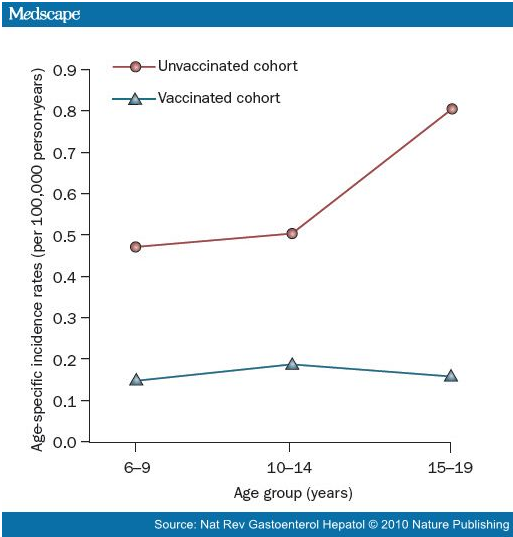肝癌的预防
最好的治疗是预防疾病的发生。肝癌的治疗首先是肝癌的预防,这是肝癌治疗的终极目标。超过数十年的持续研究逐渐证明了慢性病毒性肝炎和肝硬化一起构成HCC的最重要的起因,目前在缺乏可行的根治疗法时,避免HCC最有效的措施是HBV和HCV传染的初级预防(下表)。在1984年开始HBV接种的逐步引进,190个世界卫生组织中的164会员国在2006年普遍实现HBV接种(不管母亲乙型肝炎表面抗原的状态,所有新出生的婴孩都接种)。这些接种疫苗计划导致HBV传染迅速下降【1】。来自台湾的一项队列研究显示,在年龄和性的调整以后,比较未被接种过相似年龄的孩子,孩子6-19岁之间的接种HBV疫苗,HCC的相对风险是0.31【2】。新出生的婴孩的普遍接种将导致HCC发病率全球性持续减少,特别是在HBV有高发生的地区。
不幸地是由于病毒复制时HCV核糖核酸高突变率的困难,还没有HCV的疫苗可以应用。因此关键的是需要在医疗保健方面认识和防止HCV传输以及其它高危险的行为,例如禁止无执照的行医人员和传染控制措施,输血之前潜在患有肝炎的捐赠者和接受输血个人的筛查;使用一次性注射器和其他器械(例如,检查的血糖收集管等);彻底消毒包括外科器械在内的各种进入人体内的器械。这些措施应该是预防HCC主要措施,特别是在不安全的医疗环境资源有限的地区,这些地区病毒性肝炎和HCC的治疗经常是不充分的。通过公众教育和提高社会意识鼓励避免肝炎病毒传染的危险的行为是防止HCV导致的HCC一项有效的措施。例如酗酒,糖尿病,肥胖病和抽烟,也是重要的,特别是在有慢性病毒性肝炎的病人【3-6]】。
抗病毒治疗可减少慢性病毒性肝炎病人患HCC的风险。拉米夫定( Lamivudine)治疗可以进一步降低慢性HBV肝炎患者从肝硬化到肝癌的风险,对于还没有肝硬化的肝炎病人也有效【7-9】。对于持续病毒反应(sustained virologic response,SVR)的患者,干扰素和用于HCV的病毒唑(ribavirin)可减少患HCC的风险;然而,没有SVR的患者仍继续有患HCC的高风险[10-12]。HCV相关代偿肝硬化肝病的病人,SVR抗病毒治疗也似乎减少HCC的风险。【10,11,13】。然而HCV和晚期肝纤维化而没有SVR的病人,维持抗病毒治疗不减少疾病进展,包括HCC的风【[14】。 问题是,尽管抗病毒治疗已经被证实减少治疗HIV的治疗花费(例如,US President's Emergency Plan for AIDS Relief 已经拯救非洲一千两百万人的生命),但在欠发达地区以持续较高的价格购买治疗乙肝病毒的的药物是不现实的,这种情况必须改变,以使这种药物能够用于需要的人们。
2. Chang, M. H. et al. Decreased incidence of hepatocellular carcinoma in hepatitis B vaccinees: a 20-year follow-up study. J. Natl Cancer Inst. 101, 1348-1355 (2009). 3. Hassan, M. M. et al. Risk factors for hepatocellular carcinoma: synergism of alcohol with viral hepatitis and diabetes mellitus. Hepatology 36, 1206-1213 (2002). 4. Ohki, T. et al. Obesity is an independent risk factor for hepatocellular carcinoma development in chronic hepatitis C patients. Clin. Gastroenterol. Hepatol. 6, 459-464 (2008). 5. Lok, A. S. et al. Incidence of hepatocellular carcinoma and associated risk factors in hepatitis C-related advanced liver disease. Gastroenterology 136, 138-148 (2009). 6. Chen, C. L. et al. Metabolic factors and risk of hepatocellular carcinoma by chronic hepatitis B/C infection: a follow-up study in Taiwan. Gastroenterology 135, 111-121 (2008). 7. Liaw, Y. F. et al. Lamivudine for patients with chronic hepatitis B and advanced liver disease. N. Engl. J. Med. 351, 1521-1531 (2004). 8. Matsumoto, A. et al. Efficacy of lamivudine for preventing hepatocellular carcinoma in chronic hepatitis B: A multicenter retrospective study of 2795 patients. Hepatol. Res. 32, 173-184 (2005). 9. Yuen, M. F. et al. Long-term lamivudine therapy reduces the risk of long-term complications of chronic hepatitis B infection even in patients without advanced disease. Antivir. Ther. 12, 1295-1303 (2007). 10. Cammà, C., Giunta, M., Andreone, P & Craxl, A. Interferon and prevention of hepatocellular carcinoma in viral cirrhosis: an evidence-based approach. J. Hepatol. 34, 593-602 (2001). 11. Nishiguchi, S. et al. Prevention of hepatocellular carcinoma in patients with chronic active hepatitis C and cirrhosis. Lancet 357, 196-197 (2001). 12. Yoshida, H. et al. Interferon therapy reduces the risk for hepatocellular carcinoma: national surveillance program of cirrhotic and noncirrhotic patients with chronic hepatitis C in Japan. IHIT Study Group. Inhibition of Hepatocarcinogenesis by Interferon Therapy. Ann. Intern. Med. 131, 174-181 (1999). 13. Papatheodoridis, G. V., Papadimitropoulos, V. C. & Hadziyannis, S. J. Effect of interferon therapy on the development of hepatocellular carcinoma in patients with hepatitis C virus-related cirrhosis: a meta-analysis. Aliment. Pharmacol. Ther. 15, 689-698 (2001). 14. Di Bisceglie, A. M. et al. Hepatitis C-related hepatocellular carcinoma in the United States: influence of ethnic status. Am. J. Gastroenterol. 98, 2060-2063 (2003). | ||||||||||


